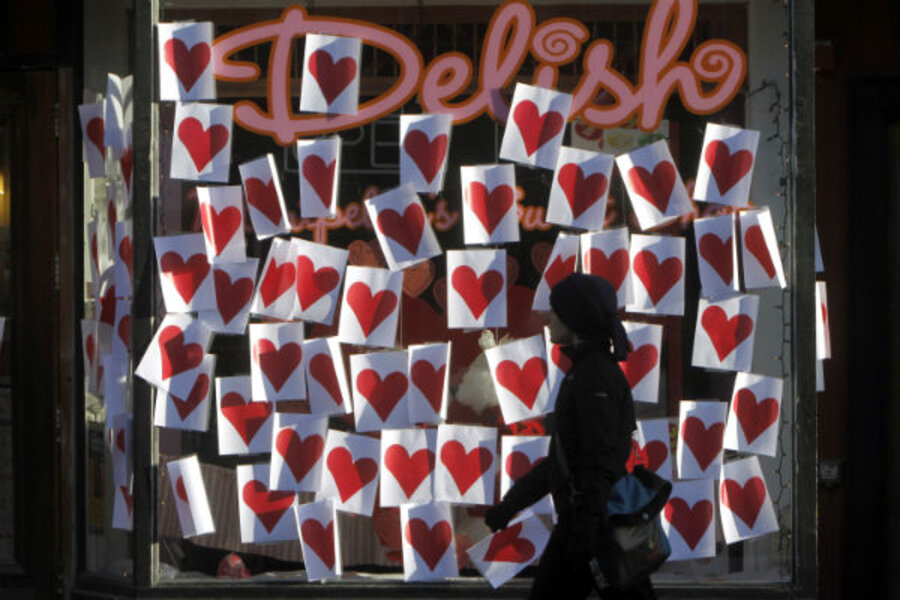Sharing a meal is the best Valentine's Day gift
Loading...
There are many ways to say “I love you,” sang the late, great Mr. Rogers. One of the best is having a meal with a friend. On a typical Valentine’s Day, the National Restaurant Association estimates, a quarter of all Americans dine out.
But sometimes, especially when the family is young, you want to stay home and wrap the parental love around the children, including them in on the meal, too, romance notwithstanding. Who else is going to eat your two dozen cupcakes topped with pink icing and red jimmies?
In our house, the sweetest Valentine’s memories are of annual candlelight dinners for two, served in the living room by the fire, on the white linens and the good china, with Mozart in the background. All this was staged and delivered up by the children – no lie – the oldest by around age 7 ceremoniously presenting a main dish, flanked by his conscientious little sisters processing in with items that wouldn’t spill.
As with the Mother’s Day breakfasts in bed, sometimes this meal took a long, long time to appear on the table, and it often was preceded by some startling sound or commotion coming from the kitchen, where I was not permitted. I have no recollection of what food was served. Nor where the whole ritual came from. Surely my husband was involved.
In the grown up world, it’s hard to make a meal for a friend, what with the calorie counting, the gluten, the fact that few of us have the Barefoot Contessa’s culinary aplomb, let alone her herb garden. And it’s not easy having someone cook for you, either. After all, dining has become a litany of what’s banned: no butter, eggs, or cheese; no red meat, whole milk, or breadstuffs; no shell fish, sugar, or desserts. “I’ll just have four stalks of asparagus, a little vinegar on the side, please.” Surely, nature must have graced us with some as-yet-unidentified substance that is unleashed by the bonhomie of the table, something that temporarily negates the alleged devastation to the body linked to food.
It feels so good to feed another, doesn’t it? Though it takes a lot of time not always allotted to things domestic, the payback is big. In both directions. It really does bond you. Baking bread for someone, in the most basic sense, nourishes them and gives them life. Breaking it together completes the circle. Culture recognizes this – in holiday customs, in literature, art, and film. Religion has the manna in the desert and the apostles in the upper room. Rituals as diverse as the Hindu puja, the Christian communion, and the Jewish Passover make the meal central.
Our Valentine’s dinner squad has moved to their own kitchens. But memorable meals continue here. Sometimes – well, often – someone will even ask to come to dinner, and invariably that someone turns into eight or nine someones. One of them asked me recently “How do you get stuck with all that cooking?” But it’s not like that. What better sound is there, really, than ten people sitting around the table, happy, hungry, grateful, having bursts of laughing, then joking, telling stories, and laughing some more? So that, by the end of the evening, the candles have burned all the way down and still no one is leaving the table? I love that.
Every now and then – and not necessarily on Valentine’s Day – I’ll get a call from one of my children, now young adults: “My friend had a bad day, Mom. How do I make her some chicken?” Or “How much sweet sausage do I need to buy for two?” And then: “What should I do with it?” There are variations on the theme: the impromptu get-acquainted dinner organized by one of the kids for the dorm, the cajoling of an estranged friend into coming along for dinner with the group, and thus rejoining the fold. As a mother, these are among my favorite kinds of calls. They get it. They know what a gift it is.
Perhaps a sparkly something in a Tiffany box is in the works for you this Valentine’s Day. Or maybe you’ll be surprised with a getaway to a place in the sun. But, if your life is really good, you’ll have the chance to make a little meal for a friend – or nine. Or maybe someone will make one for you. Everyone will be full. Guaranteed.








